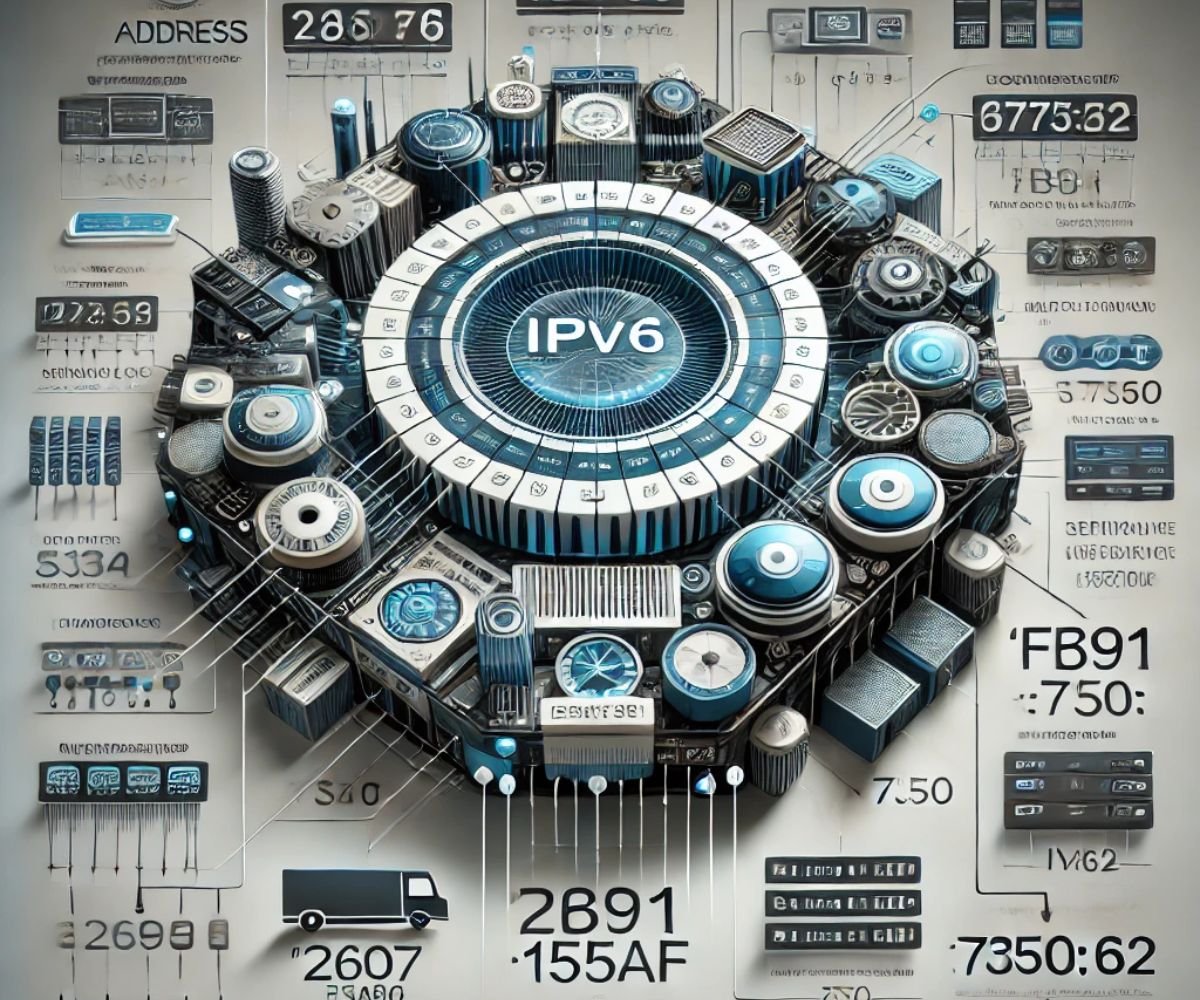With the rapid growth of devices connected to the internet, the need for a larger pool of IP addresses has become critical. The introduction of IPv6 addresses (Internet Protocol version 6) addresses this demand, replacing the older IPv4 protocol to provide an exponentially larger number of IP addresses. One example of an IPv6 address is 2607:fb91:15af:7350::62, which demonstrates the new structure and capacity that IPv6 offers.
This article will dive into what IPv6 addresses are, why they are necessary, and how addresses like 2607:fb91:15af:7350::62 work. We’ll also explore the advantages of IPv6 over IPv4, especially as the world becomes more interconnected through the Internet of Things (IoT), mobile devices, and smart technology.
What is IPv6 and Why Is It Important?
IPv6 is the latest version of the Internet Protocol, a set of rules that devices use to identify and communicate with each other over the internet. The previous version, IPv4, has been the backbone of internet communication for decades. However, due to the finite number of available IPv4 addresses (approximately 4.3 billion), the world is quickly running out of these addresses as more devices connect to the internet. This is where IPv6 comes in, offering a virtually unlimited number of addresses.
An IPv6 address, such as 2607:fb91:15af:7350::62, is made up of 128 bits, compared to IPv4’s 32 bits. This expanded address space means that IPv6 can accommodate trillions of devices, ensuring that every internet-enabled device can have a unique IP address for communication.
Breaking Down IPv6 Address 2607:fb91:15af:7350::62
IPv6 addresses are written as eight groups of four hexadecimal digits, separated by colons. However, IPv6 also allows for abbreviations by omitting leading zeroes or using the double-colon (::) to replace consecutive zeroes for a cleaner format. In the case of 2607:fb91:15af:7350::62, the “::” indicates that a group of zeroes has been omitted to shorten the address.
Here’s how 2607:fb91:15af:7350::62 breaks down:
- 2607: The first group, known as the network prefix, represents the global routing prefix. It identifies the network that this address is part of.
- fb91:15af:7350: These groups further specify subnets or specific networks within the global network, allowing for detailed routing and communication within an organization or region.
- ::62: The double colon represents the omission of consecutive zero blocks in the address, making it shorter for convenience. The number “62” at the end could represent a specific device or interface on the network.
This hierarchical structure of IPv6 enables better routing efficiency and allows for more granular control over IP address assignments, ensuring that large organizations and service providers can manage millions of devices efficiently.
Why IPv6 Matters: Benefits Over IPv4
IPv6 isn’t just about having more addresses—it offers several improvements and features that make it more efficient and secure than IPv4. Here are some key advantages:
1. Expanded Address Space
The primary benefit of IPv6 is its expanded address space. With IPv4, there are approximately 4.3 billion addresses available. In contrast, IPv6 provides 340 undecillion (that’s 340 followed by 36 zeroes) addresses, ensuring that there will be enough IP addresses for the foreseeable future, even with the continued growth of IoT devices and internet connectivity.
2. Improved Routing Efficiency
IPv6 simplifies packet processing by reducing the complexity of the header in each data packet. This streamlined process helps routers manage traffic more efficiently, especially as the number of connected devices continues to rise. Addresses like 2607:fb91:15af:7350::62 are designed to facilitate smoother data transmission, ensuring faster, more reliable internet connections.
3. Better Security
IPv6 has built-in security features, such as IPsec (Internet Protocol Security), which provides end-to-end encryption and authentication at the IP layer. This makes IPv6 inherently more secure than IPv4, which only implements IPsec as an optional feature.
4. Elimination of NAT (Network Address Translation)
In IPv4, Network Address Translation (NAT) was introduced to extend the life of the limited address pool by allowing multiple devices on a local network to share a single public IP address. However, NAT adds complexity and can create issues with certain types of connections. IPv6 eliminates the need for NAT, as every device can have its unique, globally routable address, like 2607:fb91:15af:7350::62, which simplifies network management and improves performance.
Applications and Use Cases for IPv6
The transition from IPv4 to IPv6 is crucial for industries and technologies that require the connection of vast numbers of devices. Some key areas where IPv6, and addresses like 2607:fb91:15af:7350::62, are being implemented include:
1. Internet of Things (IoT)
The Internet of Things involves billions of devices—smart home gadgets, sensors, wearables, and more—that communicate over the internet. IPv6’s massive address space makes it the ideal protocol for supporting IoT, ensuring that every device can have a unique address for direct communication and data sharing.
2. Mobile Networks
As mobile devices continue to proliferate, network providers are shifting to IPv6 to accommodate the increased demand for IP addresses. This shift allows for faster, more reliable connections for smartphones, tablets, and other connected devices.
3. Cloud Computing and Data Centers
IPv6’s scalability and routing improvements make it a valuable asset for cloud computing platforms and data centers. With more efficient packet handling and improved network management, IPv6 allows data centers to manage large volumes of traffic without the limitations of IPv4.
4. Streaming and Real-Time Applications
IPv6 improves Quality of Service (QoS) by offering more efficient routing and packet processing. This is especially beneficial for streaming services, gaming, and other real-time applications that require fast, stable internet connections. Addresses like 2607:fb91:15af:7350::62 ensure that data can be transmitted smoothly across vast networks.
Transitioning from IPv4 to IPv6
While IPv6 is the future of internet addressing, the transition from IPv4 is a gradual process. Many networks currently run a dual-stack configuration, where devices and servers are configured to handle both IPv4 and IPv6 traffic. Over time, as more service providers, enterprises, and individual users adopt IPv6, we will see IPv4 usage decline.
The transition is particularly important for organizations managing large networks or expanding their services to accommodate more users. By adopting IPv6 addresses like 2607:fb91:15af:7350::62, businesses can future-proof their infrastructure and prepare for a world with an ever-growing number of connected devices.
FAQs
What is IPv6?
IPv6, or Internet Protocol version 6, is the latest version of the Internet Protocol designed to replace IPv4. It offers a vastly larger pool of IP addresses and improves network efficiency and security.
How does IPv6 differ from IPv4?
IPv6 uses 128-bit addresses, allowing for trillions of unique IP addresses, while IPv4 uses 32-bit addresses, which limits the number of available addresses. IPv6 also provides better routing, security, and eliminates the need for NAT.
What is the structure of IPv6 addresses like 2607:fb91:15af:7350::62?
IPv6 addresses consist of eight groups of four hexadecimal digits, separated by colons. They can be abbreviated by omitting leading zeros or replacing consecutive zero groups with a double-colon (::) for brevity.
Why is IPv6 important for IoT?
IPv6 provides a massive pool of addresses, allowing every IoT device to have a unique IP address, which is crucial for direct communication and data exchange in large-scale networks.
How can businesses benefit from transitioning to IPv6?
Businesses adopting IPv6 can future-proof their networks, improve security, and enhance performance, particularly as the number of internet-connected devices continues to grow.
What are the challenges of transitioning from IPv4 to IPv6?
The main challenge is that many networks still rely on IPv4. The transition requires updating hardware, software, and infrastructure to support dual-stack configurations that handle both IPv4 and IPv6 traffic.
Conclusion: The Future of Networking with IPv6
As the number of internet-connected devices continues to grow, IPv6 is the key to unlocking the full potential of the internet. The ability to manage billions of devices with unique IP addresses, improve security, and streamline network management makes IPv6 a crucial part of the future of networking. Addresses like 2607:fb91:15af:7350::62 exemplify the structure and flexibility that IPv6 offers, and they will play a significant role in shaping the next generation of internet connectivity.
For businesses, developers, and tech enthusiasts, understanding and adopting IPv6 is essential to staying ahead in a world that is rapidly becoming more interconnected. As more organizations make the switch, IPv6 will help create a faster, safer, and more reliable internet experience for everyone.



